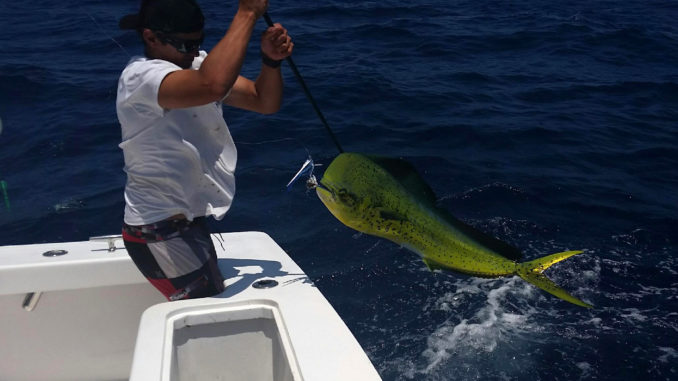
Dolphin flood SC bluewaters this month
Spring is by far the best time to take a trip to the Gulf Stream out of South Carolina’s coastal ports. Tuna and wahoo begin the frenzy in early March, followed by a major push of dolphin, aka Mahimahi, into the area as waters warm in May. And this dolphin migration is never something for any offshore junkie to miss.
Gasper Marino of Wadmacallit Sportfishing Charters out of Charleston, S.C., said the dolphin action can be fast and furious — and well worth the price of admission.
“Dolphin migrate up the coast from Florida in large schools, and it can be (so) hot we have to reduce the number of rods in our normal spread to keep up with the bites,” said Marino (843-514-4117). “The dolphin show up in May, and will be available in big numbers well into June.”
As dolphin migrate up the coast, they generally move into the area quickly and in large groups, and they are very predictable. When dolphin arrive, the word spreads like the plague. Marino keeps an eye on reports from boats in south Florida and then in Georgia.
“I know when they are off the coast of Savannah, it is only a matter of days the dolphin will be within reach in our waters,” he said.
Marino uses different tactics for dolphin than for tuna and wahoo. Water temperature and surface debris are the most-important variables to look for while hunting dolphin.
“I look for temperature breaks, current breaks and anything different in the water to concentrate the fish. A color change and a weed line are great places to start fishing, and I will not start fishing until I see something promising,” Marino said.
Dolphin are highly mobile and will travel long distances during their migratory run. But they will congregate around floating structure and debris where bait also congregates.
“I will stop and fish these areas for 20 minutes and then keep running if we don’t get bit,” he said.
Marino is prepared to run 70 to 80 miles, but when he finds the right components, he will drop his lines and try to tease the school to the boat.
Dolphin expect bait to be huddled in groups, so Marino uses teasers and a tight spread of baits and lures pulled closer to the boat to emulate a school of bait. But he is prepared to make quick changes as needed to get more fish hooked up.
“We will make adjustments depending on the color of the water and how the fish react to our spread. When we get on them, we make every attempt to stay on them, because they can get away,” he said.
According to Marino, boat traffic can scatter a school of dolphin in a flash.
“The more successful days are (the ones) with fewer boats around,” he said.


Be the first to comment